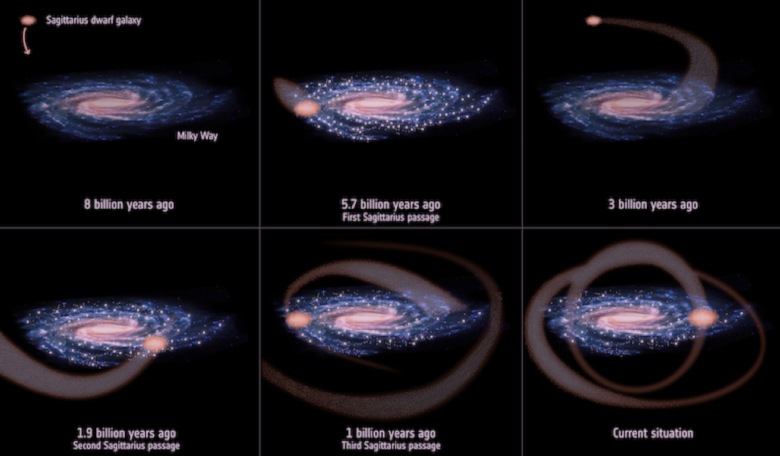Periodic clashes between the Milky Way with a smaller satellite galaxy known as Sagittarius has not only influenced the movement of stars in our galaxy, but could also be responsible for the formation of the Solar System, say scientists studying data from ESA’s ambitious mapping satellite Gaia.
Since its launch in December 2013, ESA’s Gaia (Global Astrometric Interferometer for Astrophysics) satellite has transformed our understanding of the Milky Way by producing the most precise three-dimensional map of our galaxy to date; a feat scientists have managed by piecing together about 73 Terabytes of data produced by Gaia as it observed around one billion stars an average of 70 times each over five years.
But even before Gaia started churning out 40 Gigabytes of information per day, astronomers were already aware of the chaos galactic mergers between our galaxy and other smaller satellites had caused.
One such disrupter is Sagittarius, an elliptical loop-shaped satellite galaxy of the Milky Way that contains four globular clusters.
Located around 20 kiloparsecs (65 light years) away, past studies had showed that Sagittarius had not only caused perturbations in a set of stars near the Milky Way's core when it sailed past our galaxy, but that it might have also been responsible for forming our galaxy’s trademark spiral structure.
At over 10, 000 times more massive than Sagittarius, the Milky Way’s transformation did not happen overnight however, and scientists suggest it could have taken at least three crashes, one about five or six billion years ago, then about two billion years ago, and finally one billion year ago, to shape our galaxy into the structure we see today.
Now a new study by European scientists has revealed for the first time that one of these encounters could be even more important than previously thought.
After analysing the ages of tens of millions of stars in a 6,500 light-year radius bubble around the Sun in order to understand star-forming events, researchers uncovered a striking coincidence; each time Sagittarius got uncomfortable close to the Milky Way, it kicked off a round of frenzied star formation.
“When we looked into the Gaia data about the Milky Way, we found three periods of increased star formation that peaked 5.7 billion years ago, 1.9 billion years ago and 1 billion years ago, corresponding with the time when Sagittarius is believed to have passed through the disc of the Milky Way,” says Tomás Ruiz-Lara, a researcher in Astrophysics at the Instituto de Astrofísica de Canarias (IAC) in Tenerife, Spain, and lead author of the new study published in Nature Astronomy.
As Sagittarius ploughed through the quiescent Milky Way, it caused all the previously still gas and dust inside the galaxy “to slosh around like ripples on the water,” says Ruiz-Lara.
In some areas these ripples led to higher concentrations of dust and gas which triggered the formation of new stars, while other regions got stripped of this much-needed stellar-building material.
“It seems that not only did Sagittarius shape the structure and influenced the dynamics of how stars are moving in the Milky Way, it has also led to a build-up of the Milky Way,” says Carme Gallart, a co-author of the paper, also of the IAC. “It seems that an important part of the Milky Way’s stellar mass was formed due to the interactions with Sagittarius and wouldn’t exist otherwise.”
This violent clashes, while highly disruptive, are also cause for celebrations as one encounter is suggested to be roughly coincident with the time of the formation of the Sun some 4.7 billion years ago.
“The Sun formed at the time when stars were forming in the Milky Way because of the first passage of Sagittarius,” says Carme. “We don’t know if the particular cloud of gas and dust that turned into the Sun collapsed because of the effects of Sagittarius or not. But it is a possible scenario because the age of the Sun is consistent with a star formed as a result of the Sagittarius effect.”
And Sagittarius is not done yet with causing a commotion. Existing data suggests that the dwarf galaxy might have passed through the Milky Way’s disc as recently as a few hundred million years ago, and is currently very close to it.
Indeed, Ruiz-Lara and colleagues study found evidence of a recent burst of star formation, suggesting a possible new and ongoing wave of stellar birth.
The precise dating of such star forming episodes would not have been possible without the high-quality measurements of Gaia, a mission that is also helping scientists to detect new asteroids, exoplanets, extragalactic sources such as quasars and has even provided some tests of Einstein’s theory of general relativity.
“This is really the first time that we see a detailed star formation history of the Milky Way, says ESA Gaia project scientist Timo Prusti. “It’s a testament to the scientific power of Gaia that we have seen manifest again and again in countless ground-breaking studies in a period of only a couple of years.”
If you've enjoyed reading this article, please consider subscribing to ROOM Space Journal to gain immediate and full access to the latest magazine feature articles and receive your own print and/or digital copies of the quarterly ROOM magazine delivered electronically or direct to your door.











